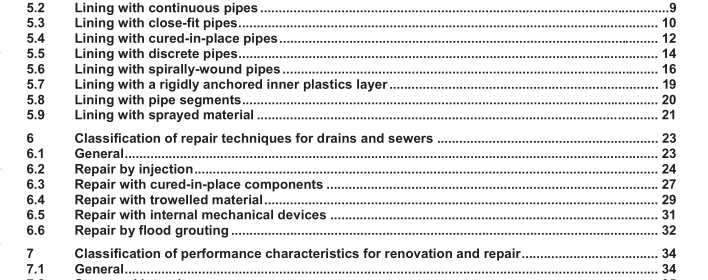EN 15885:2010 – Classification and characteristics of techniques for renovation and repair of drains and sewers

1 Scope
This European Standard specifies a system for the classification of techniques for renovation and repair of drains and sewers outside buildings, operated under gravity or pressure, including pipes, connections and manholes. It defines and describes families of techniques and their different generic methods and materials used.
This European Standard does not describe specific products.
For each technique family it lists relevant existing standards, materials and applications and outlines characteristics including installation aspects, structural and hydraulic capabilities and site impact.
Necessary work on the existing pipe prior to renovation and repair is outside the scope of this European Standard.
This European Standard provides information needed to determine viable options for identification of the optimal technique with regard to a given set of renovation and repair objectives.
NOTE It is the responsibility of the designer to choose and design the renovation and repair systems.
It does not specify the calculation methods to determine, for each viable technique, the required amount of lining material needed to secure the desired performance of the renovated pipeline.
2 Normative references
The following referenced documents are indispensable for the application of this document. For dated references, only the edition cited applies. For undated references, the latest edition of the referenced document (including any amendments) applies.
EN 752:2008, Drain and sewer systems outside buildings
3 Terms and definitions
For the purposes of this document, the following terms and definitions apply.
3.1
rehabilitation
measures for restoring or upgrading the performance of existing drain and sewer systems
[EN 752:2008, 3.50]
3.2
renovation
work incorporating all or part of the original fabric of the drain or sewer by means of which its current performance is improved
[EN 752:2008, 3.52]
3.3
repair
rectification of local damage
[EN 752:2008, 3.53]
3.4
technique family
grouping of renovation or repair techniques which are considered to have common characteristics for classification purposes
3.5
lining
process of renovating an existing pipeline by introducing material on the inside
3.6
liner
lining pipe after installation
[EN ISO 11295:2010, 3.2]
3.7
lining pipe
pipe inserted for renovation purposes
[EN ISO 11295:2010, 3.1]
3.8
lining system
lining pipe and all relevant fittings inserted into an existing pipeline for the purposes of renovation
[EN ISO 11295:2010, 3.3]
3.9
lining with continuous pipes
lining with pipe made continuous prior to insertion, and which has not been shaped to give it a cross-sectional diameter smaller than its final diameter after installation
[ISO 11296-1:2009, 3.2.1]
3.10
lining with close-fit pipes
lining with a continuous pipe for which the cross-section is reduced to facilitate installation and reverted after installation to provide a close fit to the existing pipe
[ISO 11296-1:2009, 3.2.2]
3.11
lining with cured-in-place pipes
lining with a flexible tube impregnated with a thermosetting resin, which produces a pipe after resin cure
[ISO 11296-1:2009, 3.2.3]
3.12
lining with discrete pipes
lining with short lengths of pipe which are jointed to form a continuous pipe one by one during insertion
3.13
lining with spirally-wound pipes
lining with a profiled strip, spirally wound to form a continuous pipe after installation
[ISO 11296-1:2009, 3.2.5]
EN 15885:2010 – Classification and characteristics of techniques for renovation and repair of drains and sewers